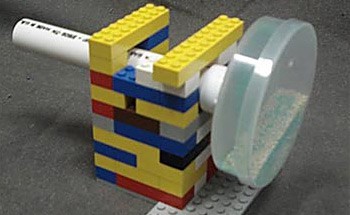Abstract
What do sand and cereal have in common? They are both granular materials, which means they are made up of solid particles, but they can actually flow like liquid. When two granular materials with very different-sized particles are mixed, you can actually separate each type by putting them in a rotating device called a tumbler. In this science project, you will examine how common household granular materials behave when mixed together in a moving containerSummary
Ben Finio, Ph.D., Science Buddies
This science project is based on a project submitted to Science Buddies by Natalia Alvarez of Northwestern University.
- LEGO® is a registered trademark of The LEGO Group.
- K'NEX® is a registered trademark of K'NEX.

Objective
Observe how common household granular materials mix or separate in a tumbler.Introduction
You may have learned that there are three types of matter: solids, liquids, and gases. For instance, rocks are solid, water is a liquid, and air is a gas. What about something like sand? You can stand on sand like a solid, but if you are making a sand castle, you can pour it out of a bucket like a liquid. Solid matter (like sand) that is made up of many individual small particles is called a granular material, and the individual particles are called grains. Granular materials can range in size from very small powders like sugar and flour that you use in your kitchen, to very large objects like rocks and boulders. Note that the word "grain" does not just refer to things you would traditionally call grains, like sand or rice; it can be any object or particle in a granular material. In order for a granular material to behave like a liquid, there must be many, many grains close together. For example, a single boulder rolling down a hill is not acting like a liquid; but thousands of rocks, boulders, and dirt particles flowing down a hill during a landslide do behave like a liquid. Similarly, a single piece of cereal does not act like a liquid, but your cereal flows like a liquid when you pour a bunch of it out of the box and into a bowl. Most of the granular materials you encounter in everyday life are food products and not big things like boulders. Figure 1 shows some examples of everyday granular materials.
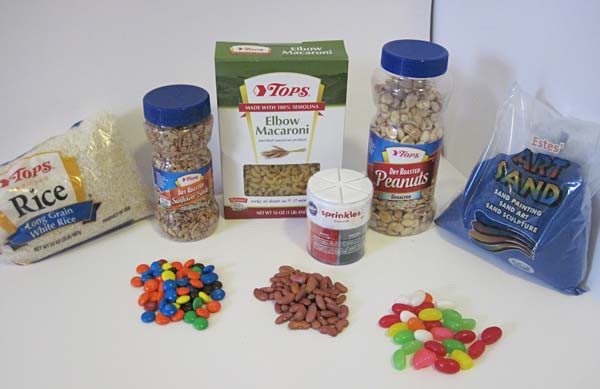 Image Credit: Ben Finio, Science Buddies / Science Buddies
Image Credit: Ben Finio, Science Buddies / Science BuddiesVarious food items are placed together, all the food items are granular or consist of many pieces. Pictured is a bag of rice, a bottle of sunflower seeds, a box of dry macaroni, a bottle of peanuts, a jar of sprinkles, a bag of art sand, a pile of M&M candies, a pile of almonds and a pile of jelly beans all placed on a countertop.
Figure 1. Examples of different granular materials that can be found at local grocery or arts and crafts stores.
Sometimes, two different granular materials are mixed together. For example, have you ever eaten cereal that has two or more different kinds of pieces? Mixing them together can actually be harder than it sounds! When two granular materials have grains that are different sizes or densities, they tend to separate by a process called segregation. This process only occurs when the mixture is moving, like in a simple device called a tumbler. A tumbler is a cylindrical container that rotates to mix granular materials, like the one shown in Figure 2. The tumbler you will make in this science project will be much smaller, and will be made of transparent plastic so you can see the granular materials inside.
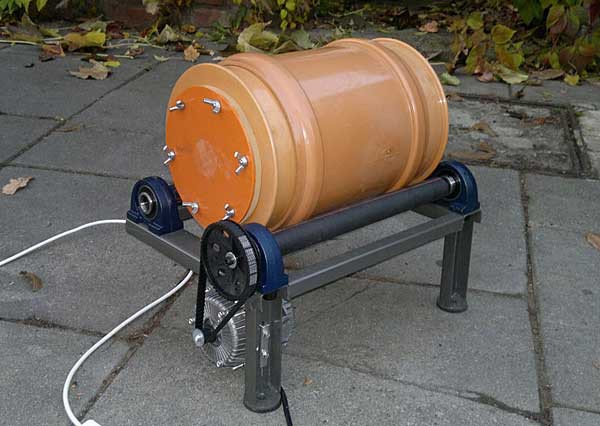 Image Credit: Wikimedia Commons / Creative Commons Attribution-NonCommercial-Share Alike 3.0 Unported
Image Credit: Wikimedia Commons / Creative Commons Attribution-NonCommercial-Share Alike 3.0 Unported
Figure 2. An example of a tumbler (Wikimedia Commons user Krakuspm, 2011).
When two different granular materials are mixed in a tumbler, segregation will occur in the flowing layer for two reasons. The first is called percolation. Percolation occurs when smaller grains fall through the spaces between larger grains (See Figure 3). As a result, large particles tend to move toward the top of the flowing layer, while small particles move toward to the bottom. Added to this process is buoyancy, meaning when dense, heavier grains sink, while lighter, less dense grains float to the top of the flowing layer. So, even if two granular materials start out perfectly mixed together, if you put them in a rotating tumbler, eventually they could completely segregate due to percolation and buoyancy.
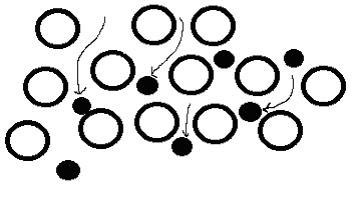 Image Credit: Northwestern University / by Northwestern University for Science Buddies
Image Credit: Northwestern University / by Northwestern University for Science Buddies
Figure 3. Percolation occurs when smaller particles fall through the spaces between larger particles.
In this physics science project, you will do an experiment to determine how two different granular materials (sand and sprinkles) separate when placed in a rotating tumbler.
Terms and Concepts
- Matter
- Grain
- Granular material
- Granular flow
- Segregation
- Tumbler
- Flowing layer
- Percolation
- Buoyancy
Questions
- Which material do you think will move to the top of the flowing layer: sand or sprinkles?
- How quickly do you think the sand and sprinkles will separate when placed in the rotating tumbler?
- Can you think of everyday examples where mixing two different granular materials might matter? For example, have you ever eaten cereal that has both oat and marshmallow pieces, or a snack mix that contains different ingredients like nuts and pretzels?
- In the examples you thought of, would you want the materials to be evenly mixed or segregated? For example, would you want all the marshmallow pieces to be at the bottom of the cereal box?
Bibliography
- Wikipedia contributors. (February 19, 2013). Granular Materials. Retrieved April 17, 2013.
- Lois, Gregg. (n.d.). Granular Materials. Retrieved April 17, 2013.
- Klishin, Sergey. (January 13, 2011). Granular flow in a rotating drum - velocity field, 58-second video. Retrieved April 17, 2013.
- Klishin, Sergey. (January 13, 2011). Granular flow in a rotating drum - velocity field, 56-second video. Retrieved April 17, 2013.
- tsuresuregusa. (May 9, 2008). Avalanche in a rotating drum, 14-second video. Retrieved May 21, 2013.
Materials and Equipment
- Wooden dowel or PVC pipe, ½-in diameter and about 12 in long, available from local hardware stores
- Duct tape
- Empty, cylindrical plastic container with a transparent lid, approximately ½-in height and 3-in diameter. Empty electrical tape or makeup containers work well. Electrical tape is available at local hardware stores and on Amazon.com. You can also use a plastic Petri dish, available at laboratory supply stores or from Amazon.com.
- Small cardboard box (like a cereal box), or building toys such as LEGOs® or K'Nex®. If using a cardboard box, you will need scissors or a knife to cut holes in it.
- Permanent marker
- Colored sand (1 bag), available at arts and crafts stores
- Colored sprinkles (the kind you might put on ice cream or cake), available at arts and crafts stores or grocery stores. Important: Make sure your sand and sprinkles are each different colors so you can easily tell them apart. We recommend using a single color of sand and a single color of sprinkles, not multi-colored packs.
- Measuring spoon set
- Digital camera (optional)
- Lab notebook
Experimental Procedure
- Use duct tape to attach the wooden dowel or PVC pipe to the bottom of your plastic container, as shown in Figure 4.
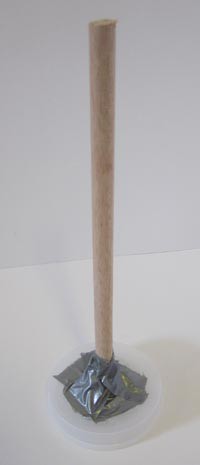 Image Credit: Ben Finio, Science Buddies / Science Buddies
Image Credit: Ben Finio, Science Buddies / Science Buddies
Figure 4. The first step in building your tumbler. Shown here is a wooden dowel attached to a Petri dish with duct tape.
- If you are using a cardboard box, have an adult use a knife to cut small circular holes (just big enough for the dowel or PVC pipe to fit through) in both sides of the box, then insert the dowel or PVC pipe through the box. If you are using building toys like LEGOs or K'Nex, build a structure that will hold the dowel or PVC pipe horizontally, while still allowing it to spin. Both options are shown in Figure 5.
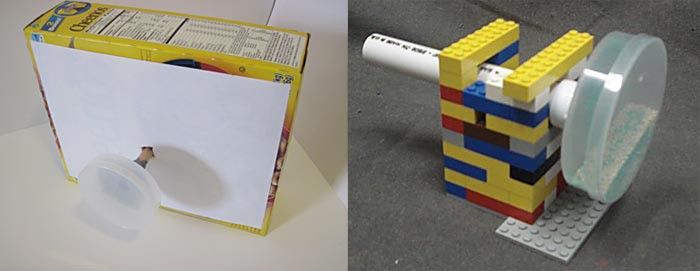 Image Credit: Ben Finio, Science Buddies / Science Buddies
Image Credit: Ben Finio, Science Buddies / Science Buddies
Figure 5. Two different ways to build a support structure for your tumbler: (left) using a cardboard box and (right) using LEGOs.
- Use a permanent marker to mark evenly spaced 0, ¼, ½ and ¾ increments on the lid of your tumbler. The marks should be 90 degrees apart, as shown in Figure 6.
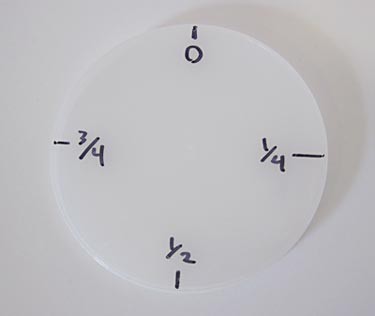 Image Credit: Ben Finio, Science Buddies / Science Buddies
Image Credit: Ben Finio, Science Buddies / Science Buddies
Figure 6. These markings on the tumbler lid will help ensure you rotate the tumbler in consistent increments.
- Temporarily remove the dowel or PVC pipe from your support structure. Mix equal amounts of sand and sprinkles (use your measuring spoons as necessary to make sure you have equal amounts). Fill your tumbler about one-fourth full with the sand-sprinkle mixture. Exactly how much material you need will depend on the size of your container.
- Put the lid on your container (if you need to, cut a strip of duct tape and put this around the outside perimeter of the container to keep the lid in place) and gently shake it until the sand and sprinkles are well mixed.
- Insert the dowel or PVC pipe back into your support structure with the "0" mark facing upward.
- If you have a digital camera, take a picture of your tumbler at this point. If your digital camera can record video, you can take video of the rotations instead. If you do not have a digital camera, make a sketch of the tumbler and how mixed or segregated (separated) the materials are.
- Slowly rotate your tumbler ¼ turn by twisting the dowel or PVC pipe. Watch the tumbler closely; can you see the flowing layer? Do the materials start to segregate? Record your observations in your lab notebook.
- If you have a digital camera, take another picture at this point. If you are recording video, just keep recording. If you do not have a camera, make a new sketch.
- Repeat steps 8 and 9 three more times, until you have completed one full rotation. Remember to record your observations at each step.
- Now see what happens if you rotate the tumbler continuously. Try to rotate it slowly and at a constant speed. Complete ten full rotations, then stop and record your observations (taking pictures or drawing sketches as necessary).
- Repeat steps 4–11, this time filling the tumbler ½ full (total) with equal amounts of sand and sprinkles. Remember to record all your observations.
- Repeat steps 4–11, filling it ¾ full (total) with equal amounts of sand and sprinkles. Remember to record all your observations.
- Finally, completely fill the tumbler with equal amounts of sand and sprinkles, and repeat steps 4–11. Does the mixture flow at all, or does it just get stuck?
- Now, compare the results for each one of your trials. Does the material flow, mix, and segregate differently depending on how full the container is? Why do you think this happens? It will help to compare pictures or sketches from each trial at each stage in the process, and it might help to make a data table like this one:
| Container | ¼ turn | ½ turn | ¾ turn | Full turn | 10 turns |
| ¼ full | |||||
| ½ full | |||||
| ¾ full | |||||
| Completely full |
Ask an Expert
Global Connections
The United Nations Sustainable Development Goals (UNSDGs) are a blueprint to achieve a better and more sustainable future for all.
Variations
- Repeat the science project using different materials, such as refined sugar or dirt.
- Build a larger tumbler using a bigger container, then try the experiment using larger amounts of granular materials. Try using bigger grains, like cereal and candy.
- This science project involved equal amounts of sand and sprinkles in each trial. What happens if you change the ratio of the materials, such as 75% sand and only 25% sugar?
- Attach a motor to the shaft of your tumbler to make it rotate at a constant speed, then take video of the segregation process.
Careers
If you like this project, you might enjoy exploring these related careers:


